- عربي
-
- share
-
subscribe to our mailing listBy subscribing to our mailing list you will be kept in the know of all our projects, activities and resourcesThank you for subscribing to our mailing list.
From Hariri's Loans to Aoun's Drought
The History of Lebanon's Foreign Aid
International development assistance has been one of the fundamental pillars of Lebanon’s post-war political economy.2 Provided by various international agencies, governments, and affiliated institutions, development assistance aims to provide support where government resources are insufficient. A plethora of countries have offered billions of US dollars to the Lebanese state to support various sectors of the economy, notably for reconstruction, the improvement of infrastructure, strengthening of security institutions, and humanitarian assistance, among other aims. Such large amounts of funds, the disbursement of which are often tied to conditionalities, have had an important impact on domestic politics, the development of national institutions, as well as, inevitably, patterns of corruption and collusion.
This article is the first in a series which analyzes a new dataset of all loan and grant agreements that Lebanon’s parliaments and governments accepted after the civil war.3 This dataset, collected and generously made available by Gherbal Initiative, includes all international assistance that is recorded in the form of a law or decree and published in the Official Gazette. Amid recent reports of mismanagement in the administration of grants of various recipient institutions,4 the dataset might miss a number of grants notably in the post-war period. It does not include grants and aid that have been provided to non-governmental institutions (which are not recorded in the Official Gazette) or are provided as in-kind contributions.5 We also do not have access to data which shows which portion of these grants and loans have been disbursed or repaid. Notwithstanding, this dataset provides the first comprehensive overview of the patterns by which governments solicited – and donors offered – international assistance.
We find that the amounts and compositions of loan and grant agreements vary over distinct time periods. During the post-war period, dominated largely by Prime Minister Rafiq Hariri, development assistance consisted mostly of loan agreements. Governments after 2011, by contrast, solicited larger shares of non-repayable grants, of which the government led by Prime Minister Tammam Salam attracted the highest amounts. The composition of assistance also differed according to presidential tenures. During the tenure of President Michel Aoun, for example, Lebanon received the fewest assistance compared to all other post-war presidential tenures, even less than during periods in which the presidency was vacant. This reduction in funds exemplifies a paradigm shift of international assistance as well as changing interests and priorities in recent years by donor countries. As conditionalities for financial assistance remain unmet amid political paralysis and virtually no progress on reforms, donors shifted funding away from financial assistance to in-kind donations and direct support to non-governmental organizations.
Soliciting loans and grants over 30 years
From 1991 to 2022, Lebanese governments signed 714 agreements to receive development assistance, totaling roughly $22.6 billion (inflation adjusted, in 2021 prices), 40% ($8.9 billion) of which were grants and 60% ($13.7 billion) loans. While there were less than half as many loan agreements than grants, loans were larger on average, the largest of which totaled more than $500 million. Development assistance at this scale is significant for an economy as small as Lebanon’s, representing more than 10% of GDP in 1991 and 2014, and more than 6% in 1995 and 2007.
Table 1: International development assistance from 1991 to 2022 (in millions of US Dollars, 2021 prices)
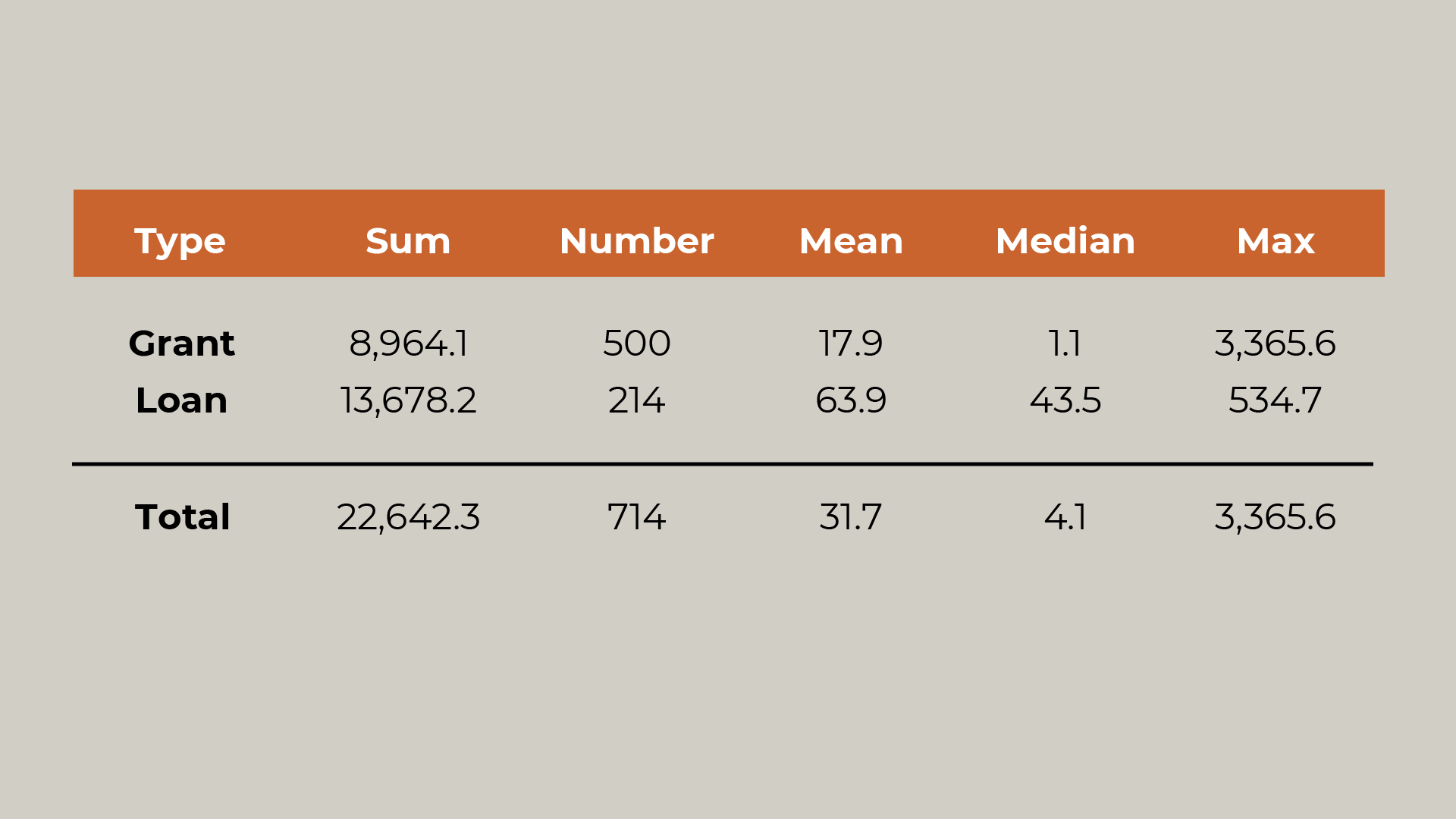
Figure 1: International development assistance in relation to national GDP (in percent) and number of agreements

Source: Lebanon Official Gazette, Gherbal Initiative, World Bank
The manner in which development assistance has been granted reflects political developments throughout Lebanon’s volatile post-war history. Five distinct periods characterize international assistance. The post-war era, until the withdrawal of Syrian troops in April 2005, was marked by a heavy reliance on loans, reflecting the growth model of successive governments led by Rafiq Hariri. During that period, Lebanon solicited more than $7.6 billion in international assistance, almost 87% of which took the form of loans. Successive post-war governments increased their portfolio of agreements each year, steadily increasing the number of agreements from six in 1992 to 40 in 2000.
In the period between the assassination of Rafiq Hariri in 2005 and the outbreak of the civil war in Syria in 2011, grants became more prominent. Loan agreements totaled roughly $2 billion, matched by an equal amount in grants. Partly in response to the conflict with Israel in 2006, donors pledged various grants for reconstruction as well as for technical assistance in administrative development.
From 2011 to mid-2016, security issues and the refugee crisis became major concerns. Significant amounts of assistance to the Lebanese Armed Forces as well as support for the response to the refugee crisis increased the share of grants to more than two-thirds of all international assistance. More than $8 billion was pledged during that period, despite long periods of political paralysis.
In 2016, this pattern changed once again after a two-year presidential vacancy and Central Bank policies that brought to the fore the dire state of state finances.6 International donors became stricter in their demand for reforms as a precondition for the disbursement of assistance,7 reducing the overall amount to $2 billion. For example, conditions for the disbursement of amounts pledged during the CEDRE conference in 2018 have never been met, resulting in very few funds being disbursed. After mass-demonstrations and the outbreak of the financial crisis in 2019, donors reduced financial commitments to state institutions to less than $1 billion. As the number of agreements dropped from 74 in 2014 to only three in 2020, assistance instead shifted to humanitarian operations to address the fallout of the crisis, such as the World Bank’s cash-transfer program. Donor programs became “people-centered” and increasingly aimed at providing targeted support in the form of in-kind contributions or direct support to non-governmental institutions. Notably, despite the government defaulting on its sovereign debt in 2020 and the significant fiduciary risks related to the treasury’s ability to repay, donors continued to grant loans for various pressing issues, which totaled more than $650 million from October 2019 to the end of 2022.8
Figure 2: Amount (in millions of US dollars) and share of loans and grants in periods
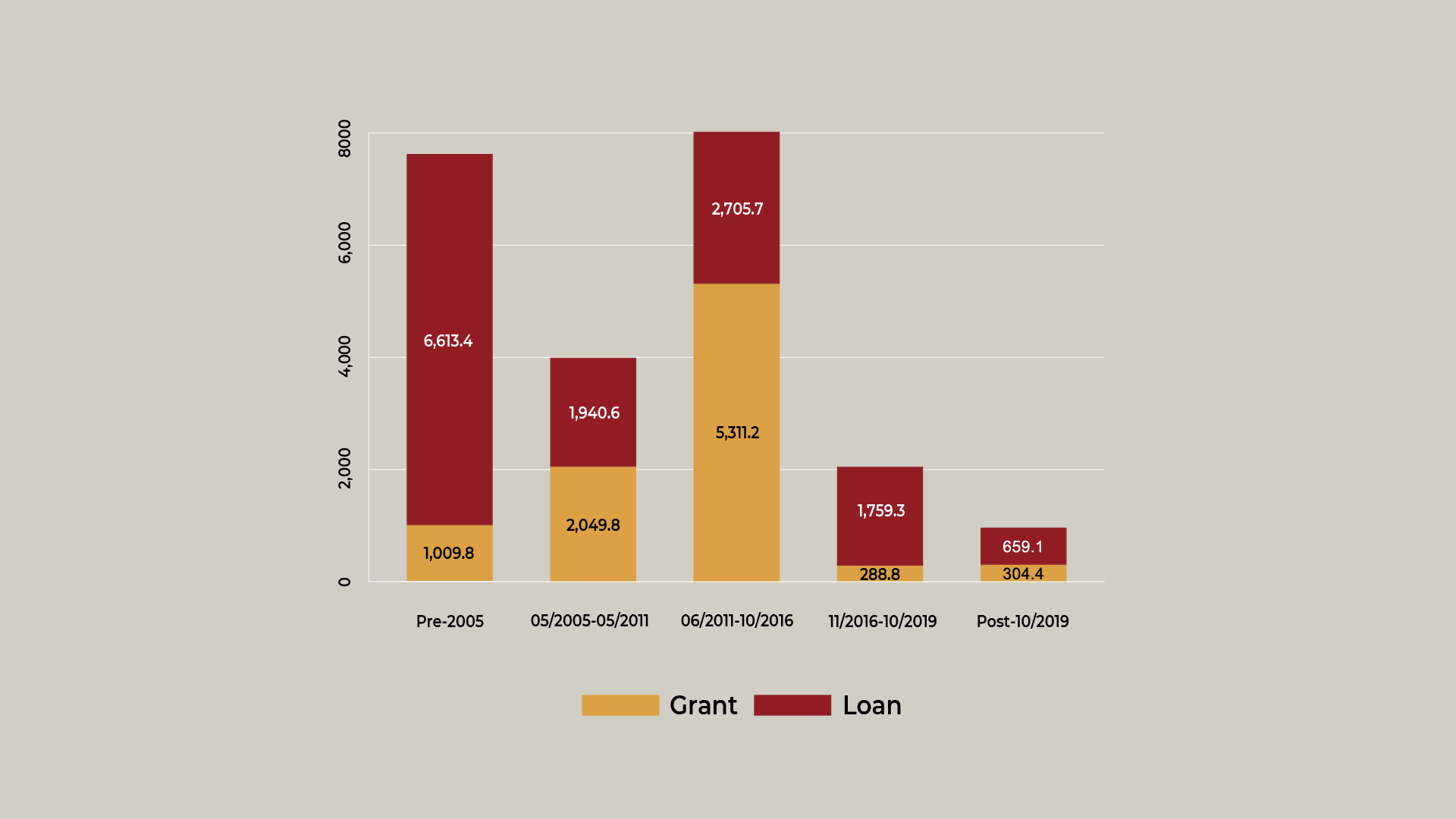
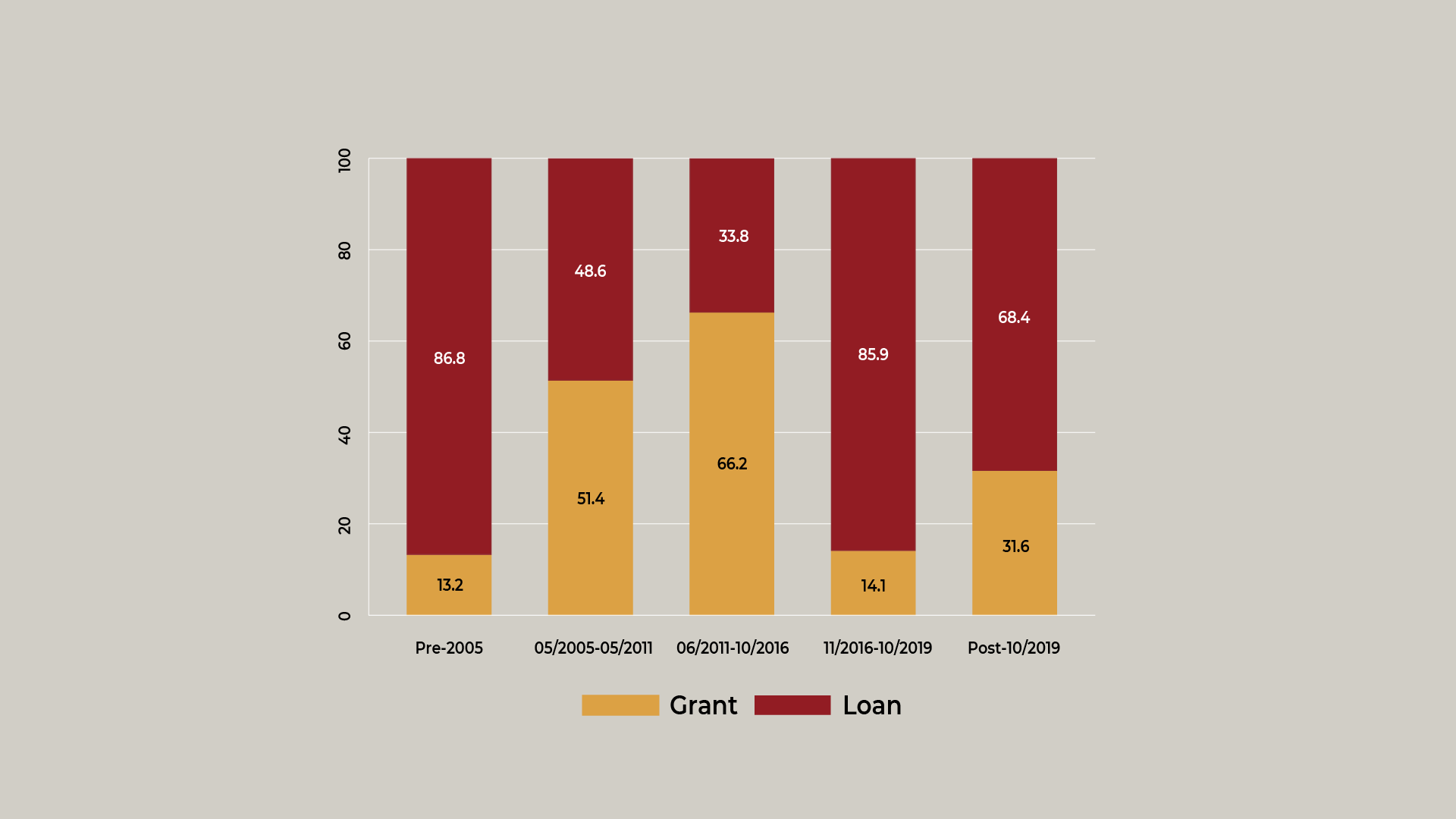
Between the loans of Hariri and the grants of Salam
The persona of prime ministers is widely perceived as being an important determinant in attracting assistance. They or their governments’ agendas can be more or less aligned with the priorities of international donors, or prime ministers can leverage personal connections to solicit grants and loans. Indeed, Lebanon’s prime ministers and presidents have a mixed record of soliciting grants and loans. While Salam’s government attracted the most grants – to the tune of more than $5.1 billion – Rafiq Hariri’s governments accepted the largest amount of loans, totaling nearly $5 billion.
Normalizing these amounts by the months a prime minister stayed in office, however, shows that prime ministers differ more in terms of their ability to solicit grants, rather than loans. Salam outranks all other prime ministers by having solicited $148 million in grants per month in office, more than four times as much as the second-placed Prime Minister Fouad Siniora. In term of loans, however, differences between prime ministers are much smaller. Apart from the government under Prime Minister Rachid Al-Solh after the civil war, all prime ministers closed loan agreements valued at $25 million to $40 million per month in office.
Figure 3: Grants and loans by prime minister, in total and normalized by months in office in millions of US dollars
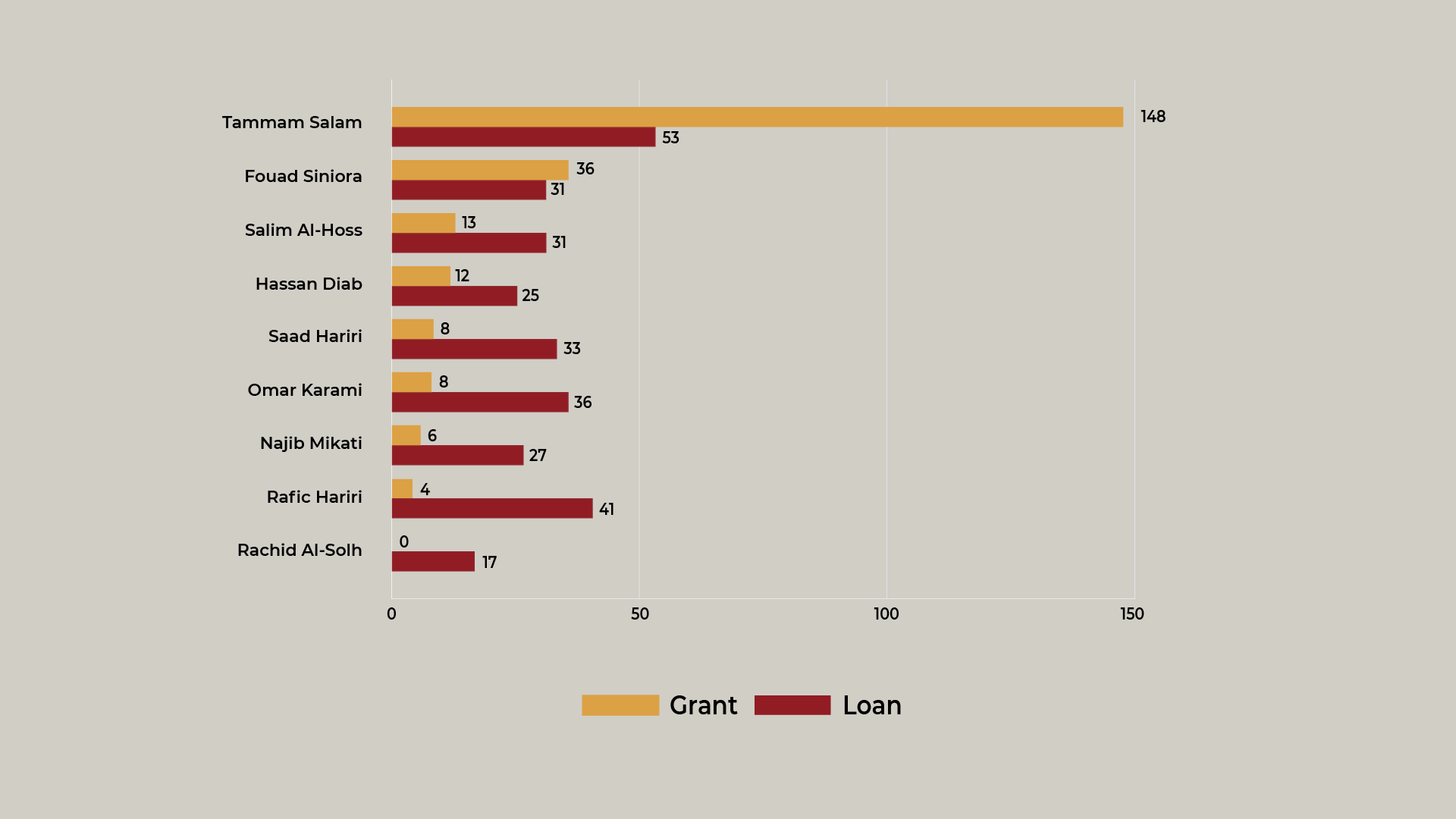

Aid with or without a president
While a prime minister outlines the program of a government, presidents are also involved in shaping strategic priorities, notably with respect to international relations. Under President Michel Sleiman (2008-2014), Lebanon’s governments solicited more than $4 billion in grants, more than during all other presidential periods. During the tenure of President Elias Hrawi (1989-1998) and President Emile Lahoud (1998-2007), governments signed the most loan agreements in the post-war era. Governments during the tenure of President Michel Aoun (2016-2022), however, solicited the least international assistance and notably only a few grants. Accordingly, the share of loans to grants was more than 80%, almost as high as during the tenure of Hrawi after the civil war (almost 90%). Even though caretaker governments have limited authority to implement conditionalities for reform, they signed agreements totaling more than $3.5 billion.
Figure 4: Amount (in millions of US dollars) and share of grants and loan agreements during presidential tenures
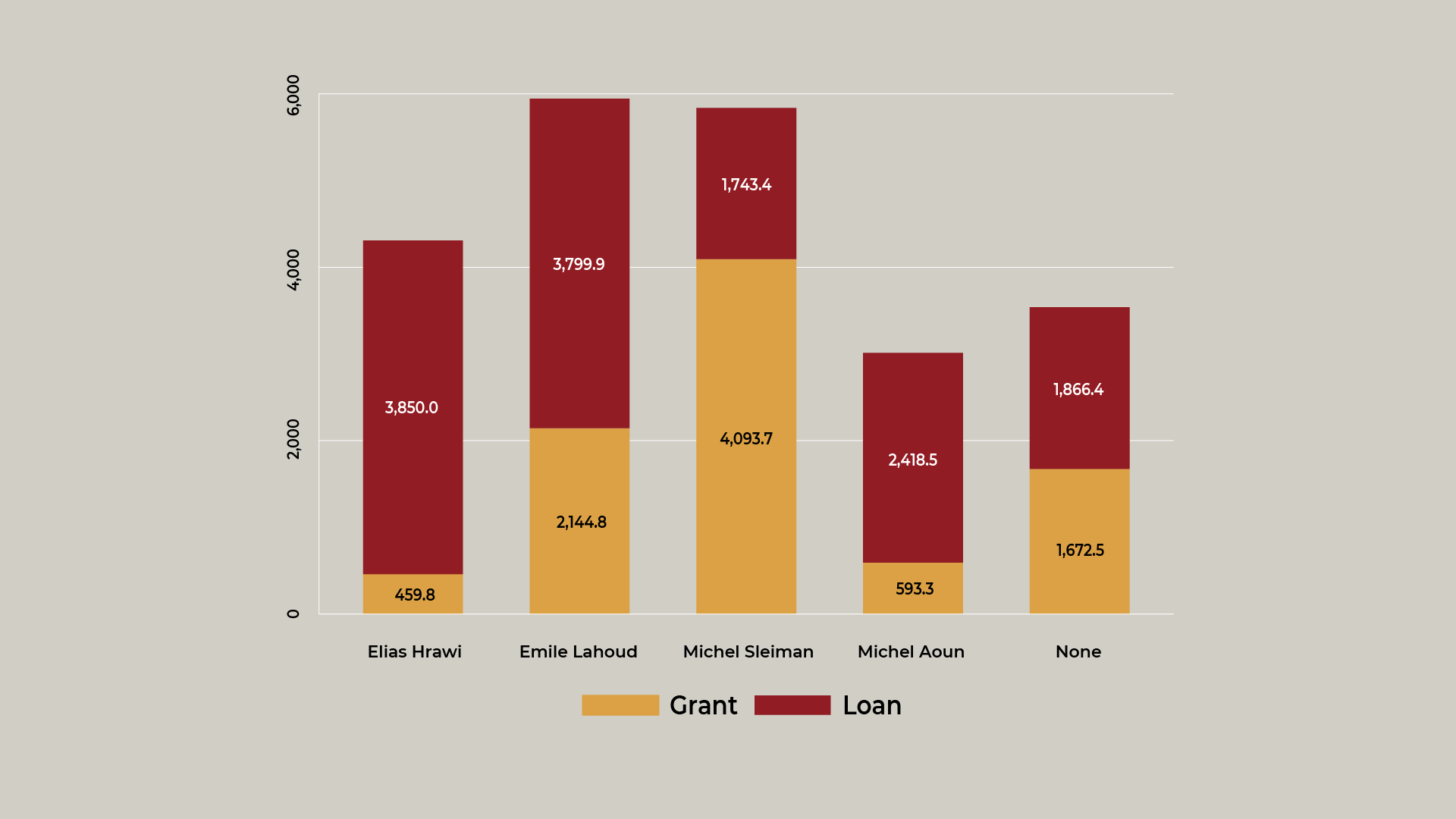
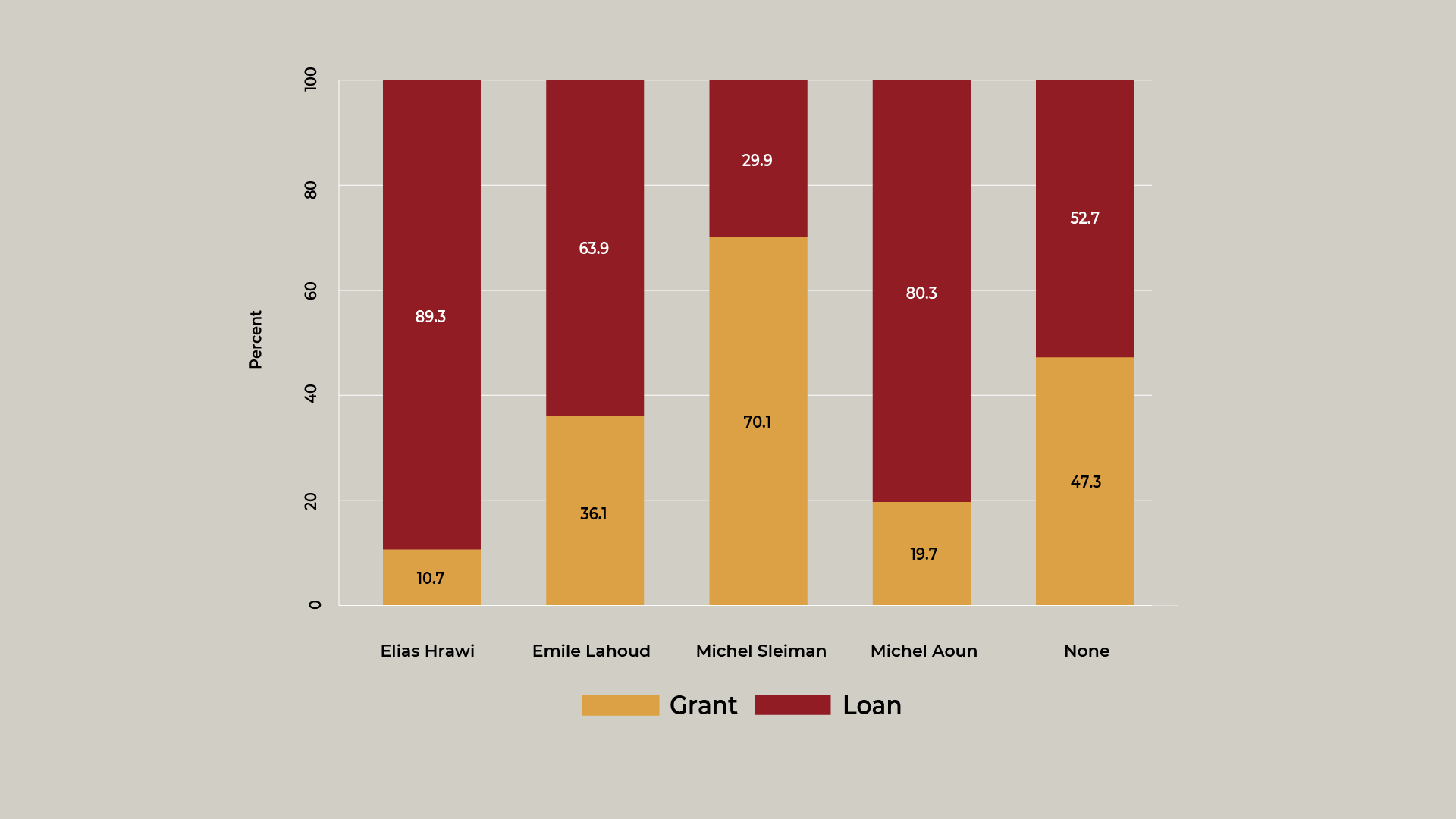
Given the importance of international development assistance to Lebanon’s political economy, incoming loans and grants mirror Lebanon’s volatile post-civil war history. Today, in the context of cascading crises, international assistance would be more important than ever to provide resources – which Lebanon’s governments will lack for years to come – to invest in dilapidated infrastructure, human development and humanitarian assistance, or institutional capacities, among so many other areas of concern. Amid prolonged political paralysis and concerns over corruption and mishandling of funds, Lebanon’s politicians will likely be unable or unwilling to deliver on the conditions for the disbursement of assistance necessary to address the egregious fallout of the present-day crises.8
1. The authors would like to thank Assad Thebian, founding director of Gherbal Initiative, for sharing the data with TPI as well as Najib Zoughaib and Wassim Maktabi for excellent research support.
2. Leenders, R., Spoils of Truce: Corruption and State-Building in Postwar Lebanon, Ithaca: Cornell University Press, 2012; Makdisi, S., The Lessons of Lebanon - The Economics of War, London: I.B. Tauris, 2004; Zahar, M.-J., Power Sharing in Lebanon: Foreign Protectors, Domestic Peace, and Democratic Failure, in Sustainable Peace: Power and Democracy After Civil Wars, P. G. Roeder and D. Rothchild, Eds., Ithaca and London: Cornell University Press, pp. 219–40, 2005.
3. Most loan and grant agreements with international institutions and foreign governments need to be accepted in the form of laws. As parliament accepts these laws, they are published in Lebanon’s Official Gazette, the governmental journal all legislation has to be published in to take effect and become legally binding. Based on these laws and decrees, we observe the details of the funding agreement, the funding agency, the grantee, the amount, the sector, and other details.
4. LBCI (2023) “Lebanon's mismanagement of internal and external grants since 1993”, Available at: https://www.lbcgroup.tv/news/news-bulletin-reports/690774/lebanons-mismanagement-of-internal-and-external-gr/en
5. We exclude in-kind donations from this view, as these take various forms and often cannot be attributed to an exact monetary value.
6. World Bank (2016) “Lebanon Economic Monitor – The great swap” The World Bank, Washington DC.
7. Deutsche Welle (2020) “Beirut Blast: Donors want reforms in return for aid”.
8. Note that our dataset includes all laws and decrees that have been published in the Official Gazette until the end of 2022. Since some legislation is published with delay after their contractual agreements, our dataset might miss out on agreements that were signed towards the end of 2022 but were not yet published or published in 2023 only.
Related Output
view allFrom the same author
view all-
06.14.24
عطاالله: التدّخل السياسي عقبة أمام تطوّر الإدارة العامة
سامي عطا اللهمقابلة مع مدير مبادرة سياسات الغد الدكتور سامي عطاالله أكد أن "التدخل السياسي هو العقبة الرئيسية أمام تطور الإدارة العامة"، وشدد على أن دور الدولة ووجودها ضروريان جدًا لأن لا وجود للاقتصاد الحر أو اقتصاد السوق من دونها"
اقرأ -
09.21.23
مشروع موازنة 2023: ضرائب تصيب الفقراء وتعفي الاثرياء
وسيم مكتبي, جورجيا داغر, سامي زغيب, سامي عطا الله -
10.12.22eng
فساد في موازنة لبنان
سامي عطا الله, سامي زغيب
More periodicals
view all-
06.14.24
عطاالله: التدّخل السياسي عقبة أمام تطوّر الإدارة العامة
سامي عطا اللهمقابلة مع مدير مبادرة سياسات الغد الدكتور سامي عطاالله أكد أن "التدخل السياسي هو العقبة الرئيسية أمام تطور الإدارة العامة"، وشدد على أن دور الدولة ووجودها ضروريان جدًا لأن لا وجود للاقتصاد الحر أو اقتصاد السوق من دونها"
اقرأ -
10.27.23eng
تضامناً مع العدالة وحق تقرير المصير للشعب الفلسطيني
-
09.21.23
مشروع موازنة 2023: ضرائب تصيب الفقراء وتعفي الاثرياء
وسيم مكتبي, جورجيا داغر, سامي زغيب, سامي عطا الله -
09.09.23
بيان بشأن المادة 26 من مشروع قانون الموازنة العامة :2023
-
08.24.23
من أجل تحقيق موحد ومركزي في ملف التدقيق الجنائي
اقرأ -
07.27.23
المشكلة وقعت في التعثّر غير المنظّم تعليق دفع سندات اليوروبوندز كان صائباً 100%
-
05.17.23
حشيشة" ماكينزي للنهوض باقتصاد لبنان
-
01.12.23
وينن؟ أين اختفت شعارات المصارف؟
-
10.12.22eng
فساد في موازنة لبنان
سامي عطا الله, سامي زغيب -
06.08.22eng
تطويق الأراضي في أعقاب أزمات لبنان المتعددة
منى خشن -
05.11.22eng
هل للانتخابات في لبنان أهمية؟
كريستيانا باريرا -
05.06.22eng
الانتخابات النيابية: المنافسة تحجب المصالح المشتركة


